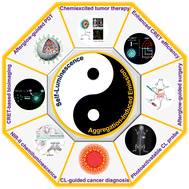State-of-the-art self-luminescence: a win–win situation
Abstract
Self-luminescence, which eliminates the real-time external optical excitation, can effectively avoid background autofluorescence in photoluminescence, endowing with ultrahigh signal-to-noise ratio and sensitivity in bioassay. Furthermore, in situ generated and emitted photons have been applied to develop excitation-free diagnostics and therapeutic agents against deeply seated diseases. “Enhanced” self-luminescence, referring to the aggregation-induced emission (AIE)-integrated self-luminescence systems, is endowed with not only the above merits but also other superiorities including stronger luminous brightness and longer half-life compared with “traditional” self-luminescence platforms. As an emerging and booming hotspot, the “enhanced” self-luminescence facilitated by the win–win cooperation of the aggregation-induced emission and self-luminescent techniques has become a powerful tool for interdisciplinary research. This tutorial review summarizes the advancements of AIE-assisted self-luminescence including chemiluminescence and afterglow imaging, starting from the discussion on the design and working principles, luminescent mechanisms of self-luminescence fuels, versatile integrated approaches and advantages, and a broad range of representative examples in biosensors and oncotherapy. Finally, the current challenges and perspectives are discussed to further actuate the development of “enhanced” self-luminescence agents for biomedical diagnosis and treatment.



 Please wait while we load your content...
Please wait while we load your content...